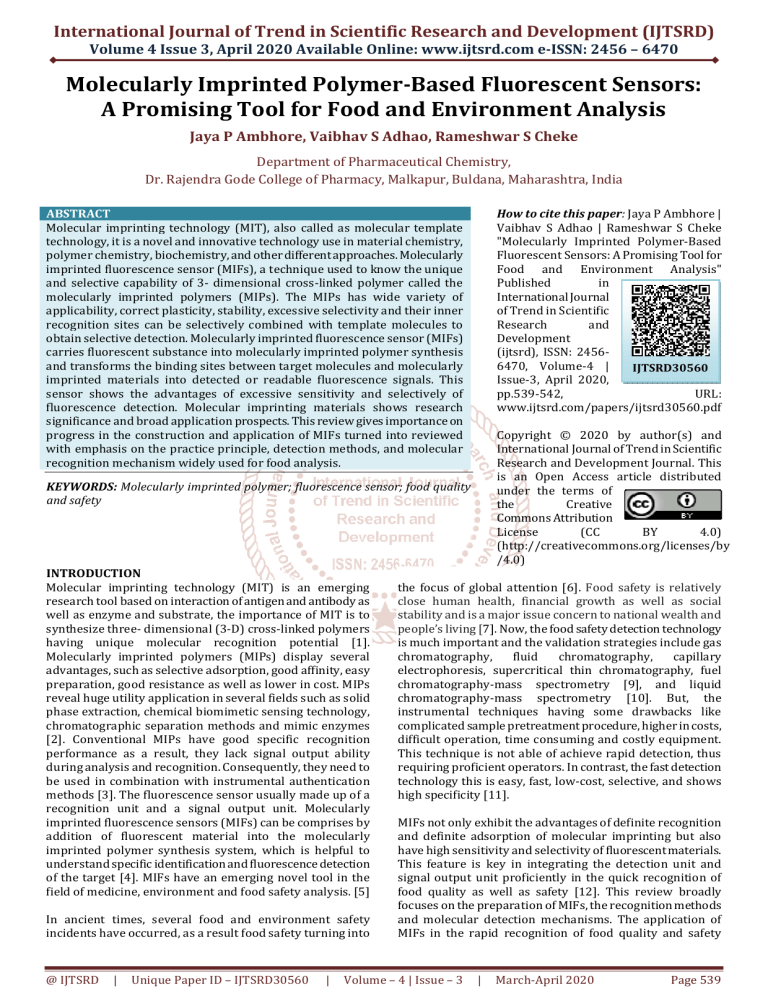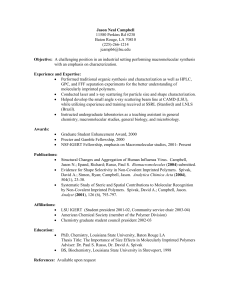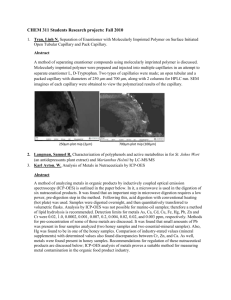
International Journal of Trend in Scientific Research and Development (IJTSRD)
Volume 4 Issue 3, April 2020 Available Online: www.ijtsrd.com e-ISSN: 2456 – 6470
Molecularly Imprinted Polymer-Based Fluorescent Sensors:
A Promising Tool for Food and Environment Analysis
Jaya P Ambhore, Vaibhav S Adhao, Rameshwar S Cheke
Department of Pharmaceutical Chemistry,
Dr. Rajendra Gode College of Pharmacy, Malkapur, Buldana, Maharashtra, India
ABSTRACT
Molecular imprinting technology (MIT), also called as molecular template
technology, it is a novel and innovative technology use in material chemistry,
polymer chemistry, biochemistry, and other different approaches. Molecularly
imprinted fluorescence sensor (MIFs), a technique used to know the unique
and selective capability of 3- dimensional cross-linked polymer called the
molecularly imprinted polymers (MIPs). The MIPs has wide variety of
applicability, correct plasticity, stability, excessive selectivity and their inner
recognition sites can be selectively combined with template molecules to
obtain selective detection. Molecularly imprinted fluorescence sensor (MIFs)
carries fluorescent substance into molecularly imprinted polymer synthesis
and transforms the binding sites between target molecules and molecularly
imprinted materials into detected or readable fluorescence signals. This
sensor shows the advantages of excessive sensitivity and selectively of
fluorescence detection. Molecular imprinting materials shows research
significance and broad application prospects. This review gives importance on
progress in the construction and application of MIFs turned into reviewed
with emphasis on the practice principle, detection methods, and molecular
recognition mechanism widely used for food analysis.
How to cite this paper: Jaya P Ambhore |
Vaibhav S Adhao | Rameshwar S Cheke
"Molecularly Imprinted Polymer-Based
Fluorescent Sensors: A Promising Tool for
Food and Environment Analysis"
Published
in
International Journal
of Trend in Scientific
Research
and
Development
(ijtsrd), ISSN: 24566470, Volume-4 |
IJTSRD30560
Issue-3, April 2020,
pp.539-542,
URL:
www.ijtsrd.com/papers/ijtsrd30560.pdf
Copyright © 2020 by author(s) and
International Journal of Trend in Scientific
Research and Development Journal. This
is an Open Access article distributed
under the terms of
the
Creative
Commons Attribution
License
(CC
BY
4.0)
(http://creativecommons.org/licenses/by
/4.0)
KEYWORDS: Molecularly imprinted polymer; fluorescence sensor; food quality
and safety
INTRODUCTION
Molecular imprinting technology (MIT) is an emerging
research tool based on interaction of antigen and antibody as
well as enzyme and substrate, the importance of MIT is to
synthesize three- dimensional (3-D) cross-linked polymers
having unique molecular recognition potential [1].
Molecularly imprinted polymers (MIPs) display several
advantages, such as selective adsorption, good affinity, easy
preparation, good resistance as well as lower in cost. MIPs
reveal huge utility application in several fields such as solid
phase extraction, chemical biomimetic sensing technology,
chromatographic separation methods and mimic enzymes
[2]. Conventional MIPs have good specific recognition
performance as a result, they lack signal output ability
during analysis and recognition. Consequently, they need to
be used in combination with instrumental authentication
methods [3]. The fluorescence sensor usually made up of a
recognition unit and a signal output unit. Molecularly
imprinted fluorescence sensors (MIFs) can be comprises by
addition of fluorescent material into the molecularly
imprinted polymer synthesis system, which is helpful to
understand specific identification and fluorescence detection
of the target [4]. MIFs have an emerging novel tool in the
field of medicine, environment and food safety analysis. [5]
In ancient times, several food and environment safety
incidents have occurred, as a result food safety turning into
@ IJTSRD
|
Unique Paper ID – IJTSRD30560
|
the focus of global attention [6]. Food safety is relatively
close human health, financial growth as well as social
stability and is a major issue concern to national wealth and
people’s living [7]. Now, the food safety detection technology
is much important and the validation strategies include gas
chromatography,
fluid
chromatography,
capillary
electrophoresis, supercritical thin chromatography, fuel
chromatography-mass spectrometry [9], and liquid
chromatography-mass spectrometry [10]. But, the
instrumental techniques having some drawbacks like
complicated sample pretreatment procedure, higher in costs,
difficult operation, time consuming and costly equipment.
This technique is not able of achieve rapid detection, thus
requiring proficient operators. In contrast, the fast detection
technology this is easy, fast, low-cost, selective, and shows
high specificity [11].
MIFs not only exhibit the advantages of definite recognition
and definite adsorption of molecular imprinting but also
have high sensitivity and selectivity of fluorescent materials.
This feature is key in integrating the detection unit and
signal output unit proficiently in the quick recognition of
food quality as well as safety [12]. This review broadly
focuses on the preparation of MIFs, the recognition methods
and molecular detection mechanisms. The application of
MIFs in the rapid recognition of food quality and safety
Volume – 4 | Issue – 3
|
March-April 2020
Page 539
International Journal of Trend in Scientific Research and Development (IJTSRD) @ www.ijtsrd.com eISSN: 2456-6470
hazard factors including agricultural and veterinary drug
residues, heavy metals, and environmental organic
pollutants as well as the research focus on progress trend on
the MIFs is discussed.
Preparation of MIPs
MIPs are category of polymeric materials obtained from
template molecules and functional monomers by means of
covalent or non-covalent bonds to form preassemblies.
Under the action of cross-linking agents and initiators, they
are afterward entirely matched with the template molecules
in shape and structure [13]. The preparation principle of
MIPs as shown in (Fig.1) and the process is generally
divided into three steps [14].
Fig.1: the preparation principle of MIPs
1.
2.
3.
Template molecules and functional monomers are
assembled in suitable solvents, and the host and guest
know each other to form stable supramolecular
complexes [15] with several definite detection sites and
specific spatial arrangement.
A cross linking agent and an initiator are added into the
assembled solution, the process of photo polymerization
or thermal polymerization is initiated by the initiator,
and a highly cross linking polymerization is performed
around
the
template-functional
monomer
supramolecular complex to form a rigid polymer with a
three-dimensional spatial structure [16].
Elute the template molecules attach to the polymer with
an eluent mostly alkyd or alkali alcoholic solution to
obtain a MIP [17] with 3-D holes that can be completely
matched to the template molecule. The imprinted
cavities can suitably bind to the template molecules
again and obtain a specific recognition effect on the
template molecules.
Construction of molecularly imprinted fluorescence
sensors MIFs
The fluorescence sensors are capable to alter the detection
between the molecular recognition unit and target into a
fluorescence response signal and detect the concentration of
the target by monitoring the fluorescence intensity. The
fluorescence sensor do change the cognizance into the
molecular consciousness soloist then target of a fluorescence
reply sign or notice the concentration over the target with
the aid of limit the fluorescence intensity, an MIFs was
constructed by introducing fluorescent materials into the
MIPs synthesis system. As shown in (Fig.2) [18]. MIFs are
greatly selective, sensitive, precise, and stable compared to
all conventional sensors [19], and have been extensively
used to identify many kinds of pollutants which is present in
environment [20].
@ IJTSRD
|
Unique Paper ID – IJTSRD30560
|
Fig.2. the preparation process of molecularly
imprinted fluorescence sensors (MIFs)
Application of MIFs in Food Quality and Safety Detection
Now a day, the determination regarding food quality or
safety hazard elements typically includes chromatography
techniques,
such
as
high-performance
liquid
chromatography, gas chromatography, and then highperformance liquid chromatography-mass spectrometry.
These strategies display the advantages about high recovery,
more reproducibility and less detection limit; however, it
hourly require a drag pattern pretreatment process.
Moreover, in that place are mean drawbacks, certain so highpriced gear and reagents, long detection time, unsuited for
detection over a tremendous number over samples, and lack
on portability. Fluorescence sensing analysis demonstrates
the character about excessive sensitivity, lower detection
limit, quickly reaction speed, helpful selectivity, low cost,
then utilization concerning exceedingly easy devices or
equipment. In recent years, including the mild progress then
aging concerning surface molecular imprinting,
nanomolecular imprinting technology, then highperformance fluorescent nanomaterials preparation
technology, the selective awareness yet fluorescence
detection overall performance on MIFs with respect to
hazard factors in complex food matrices have been
significantly enhanced [21]. The MIFs has been extensively
old within food characteristic or safety analysis. Mostly the
research focal point concerning the fluorescence detection
regarding arable then veterinary drug residues, drug
residues, prohibited additives, heavy metals, environmental
natural pollutants and other factors [22].
1. MIFs in Pesticides
A long-term and large-scale use of pesticides leads to
environmental air pollution or extended pesticide residues
between arable products, thus destroying the ecological
balance similarly rising the hazard regarding food safety.
The fluorescent MIPs is prepared by molecular imprinting
method, a three-dimensional cross linked polymer along
unique focus sites, as execute to understand selective
recognition, adsorption, and fluorescence discovery
regarding pesticide molecules (template molecules). Various
discoveries for pesticides detection like Li et al. prepared
MIPs with specific fluorescence response to cyhalothrin by
silylation of FeSe QDs. with the help of surfactant-modified
CdTe QDsas carrier and acryl amide as the functional
monomer [23]. Similarly Wei et al. reported that a
specifically recognize cyhalothrin using free radical
polymerization for the rapid fluorescence analysis of
cyhalothrin residues in River water [24]. Later Wang et al.
used SiO2-coated red QDs as a support carrier and reference
signal source using the sol-gel method [25]. Liu et al.
reported that FIPs encapsulated nitrogen-doped graphene
QDs, prepared by alkaline self-polymerization of dopamine
using dopamine as the functional monomer and cross linking
agent. The fluorescent strip was constructed for specific
Volume – 4 | Issue – 3
|
March-April 2020
Page 540
International Journal of Trend in Scientific Research and Development (IJTSRD) @ www.ijtsrd.com eISSN: 2456-6470
detection of thiamethoxam [26]. Amjadi et al. prepared a
ratio MIFs by imprinting carbon quantum dot silica spheres
and CdTe/CdS QDs in the same polymer using the sol-gel
method, in this investigation done a study of diniconazole
residues in environmental water and soil samples [27].
2. MIFs in Veterinary Drugs/Drug Residues.
In recent years, illegal use of forbidden additives, incorrect
use of veterinary drugs moreover overuse of drugs in
production, use of livestock, poultry, aquatic products have
becomes some of the important factors affecting food safety.
For example, tetracycline is mostly used in livestock and
poultry production as a broad-spectrum bacteriostatic agent.
Owing to high dosage, longer time as well as abuse of drug, it
will produce major residues in animal muscle, milk, liver,
thus endangering food safety. Due to higher selectivity as
well as proper stability, FIPs can proficiently recognize and
detect veterinary drug molecule in complex sample i.e. meat
products, blood, urine and feces to handle with a variety of
unfavorable factors. Thus the veterinary drug residue
analysis method based on MIFs demonstrate higher
sensitivity and more selectivity
3. MIFs in Heavy Metals
A rapid growth of industrial economy, the liberation of heavy
metal sewage is becoming ever more severe and poses a
major amount of hazard to the environment and creature
health. Heavy metals are extremely poisonous, toxic, not
easily degradable, bioaccumulative, and easily transfer in the
food chain. Heavy metals contaminate the agricultural
products as well as food to causing severe harm. In view of
the heavy metal contamination, the development of a simple,
rapid, and precise MIF is of huge impact to protect the
environment of agricultural products, food quality as well as
safety. Various application of MIFs was in heavy metals
detection like, Luo et al. reported a direct introduction CdTe
QDs on the surface of sulfhydryl-modified magnetic silica
spheres for quantitative analysis of Cd2+ but also for
magnetic adsorption and removal of Cd2+ [29]. Similarly Tan
et al. prepared Zn2+ and Cd2+ ion imprinting by sol-gel
blotting [30].
4. MIFs in environmental Organic Pollutants
Environmental organic pollutants such as aromatic
hydrocarbons, phenols, dyes etc contain teratogenic
carcinogenic and hazards element, which are major threats
to human health. In earlier research, the high-performance
liquid chromatography (HPLC) and mass spectrometry (MS)
were frequently to measure the content concerning urinary
albumin. While the sensitivity as well as specificity of mass
spectroscopy was high, the equipment was expensive and
detection cost was high. MIFs have been mostly employed
for speedy detection of organic pollutants in the
environment. Environmental organic pollutants were
studied by Li et al. prepared FIPs by encapsulating
YVO4:Eu3+ rare earth nanoparticles and carbon quantum dots
use for the rapid determination of p-nitrophenol in
environmental water and urine [31]. Similarly, Zhou et al.
done hydrothermally treated APTES-grapheme oxide to
obtain silylated graphene quantum dots, which were
introduced into the FIPs of p-nitrophenol by sol-gel method
[32]. Wu et al. reported the preparation of FIPs using AuCNs
for the first time and effectively applied these FIPs in the
fluorescence analysis of bisphenol in seawater [33]. Organic
pollutant analysis based on Molecular imprinted
@ IJTSRD
|
Unique Paper ID – IJTSRD30560
|
fluorescence frequently suffered from the complex matrix
interference and which will result in false positive and false
negative results. It will be essential to develop a novel
approach to construct anti-interference FIPs and MIFs for
determination of traces of environmental organic pollutants
in food and environment samples. Relatively combining a
prompt pretreatment procedure with MIFs is another useful
solution to keep away from matrix interference.
Conclusions
Molecularly imprinted fluorescence sensor combine the high
selectivity of Molecular imprinting technology with the more
sensitive response of fluorescent matter and convert the
molecular recognition into understandable fluorescence
signal. The MIFs improve the performance of molecular
imprinting and diverse range of applications, MIFs
promoting
high-efficiency
and
high-sensitivity
determination of trace substances in complex matter. MIFs is
compared to all traditional analytical techniques it reveal the
characteristics of high sensitivity as well as high selectivity
and thus display major potential and superior application
with respect to the rapid detection of food and environment
safety. Preparations of MIFs with better selectivity, higher
sensitivity, and the combination of tablet computers, and
cloud databases to construct an innovative intellectual
fluorescence rapid finding platform are of huge significance
in promoting the advance of rapid detection technology for
food and environment safety.
Conflict of interest
The authors declare that they have no conflict of interest
Reference
[1] Pan J, Chen W, Ma Y, Pan G. Molecularly imprinted
polymers as receptor mimics for selective cell
recognition. Chem. Soc. Rev. 2018; 47(15):5574-87.
[2] Gui R, Jin H, Guo H, Wang Z. Recent advances and future
prospects in molecularly imprinted polymers-based
electrochemical biosensors. Biosens. Bioelectron. 2018
Feb 15; 100:56-70.
[3] Bagheri AR, Arabi M, Ghaedi M, Ostovan A, Wang X, Li J,
Chen L. Dummy molecularly imprinted polymers based
on a green synthesis strategy for magnetic solid-phase
extraction of acrylamide in food samples. Talanta. 2019
Apr 1; 195:390-400.
[4] Wagner, S.; Bell, J.; Biyikal, M.; Gawlitza, K.; Rurack, K.
Integrating fluorescent molecularly imprinted polymer
(MIP) sensor particles with a modular micro fluidic
platform for nanomolar small-molecule detection
directly
in
aqueous
samples. Biosens.
Bioelectron. 2018, 99, 244–250.
[5] Wang J, Dai J, Xu Y, Dai X, Zhang Y, Shi W, Sellergren B,
Pan G. Molecularly imprinted fluorescent test strip for
direct, rapid, and visual dopamine detection in tiny
amount of biofluid. Small. 2019 Jan; 15(1):1803913.
[6] Ovca A, Jevšnik M, Kavčič M, Raspor P. Food safety
knowledge and attitudes among future professional
food handlers. Food Control. 2018 Feb 1; 84:345-53.
[7] Carvalho FP. Pesticides, environment, and food safety.
Food Energy Secur. 2017 May; 6(2):48-60.
[8] Chen Y, Lopez S, Hayward DG, Park HY, Wong JW, Kim
SS, Wan J, Reddy RM, Quinn DJ, Steiniger D.
Volume – 4 | Issue – 3
|
March-April 2020
Page 541
International Journal of Trend in Scientific Research and Development (IJTSRD) @ www.ijtsrd.com eISSN: 2456-6470
Determination of multiresidue pesticides in botanical
dietary supplements using gas chromatography–triplequadrupole mass spectrometry (GC-MS/MS). J. Agric.
Food Chem. 2016 Aug 10; 64(31):6125-32.
[9] Liu G, Yang X, Li T, Yu H, Du X, She Y, Wang J, Wang S,
Jin F, Jin M, Shao H. Spectrophotometric and visual
detection of the herbicide atrazine by exploiting
hydrogen bond-induced aggregation of melaminemodified gold nanoparticles. Microchim Acta. 2015 Aug
1; 182(11-12):1983-9.
[10] Rotariu L, Lagarde F, Jaffrezic-Renault N, Bala C.
Electrochemical biosensors for fast detection of food
contaminants–trends and perspective. TrAC Trends
Anal. Chem. 2016 May 1; 79:80-7.
[11] Sun A, Chai J, Xiao T, Shi X, Li X, Zhao Q, Li D, Chen J.
Development of a selective fluorescence nanosensor
based on molecularly imprinted-quantum dot
optosensing materials for saxitoxin detection in
shellfish samples. Sens. Actuators B Chem. 2018 Apr 1;
258:408-14.
[12] Wang QH, Fang GZ, Liu YY, Zhang DD, Liu JM, Wang S.
Fluorescent sensing probe for the sensitive detection of
histamine based on molecular imprinting ionic liquidmodified quantum dots. Food Anal. Methods. 2017 Jul
1; 10(7):2585-92.
[13] Ayankojo AG, Reut J, Öpik A, Furchner A, Syritski V.
Hybrid molecularly imprinted polymer for amoxicillin
detection. Biosens. Bioelectron. 2018 Oct 30; 118:1027.
[14] Culver HR, Peppas NA. Protein-imprinted polymers:
The shape of things to come?. Chem. Mater. 2017 Jul
25; 29(14):5753-61.
[15] Boulanouar S, Mezzache S, Combès A, Pichon V.
Molecularly imprinted polymers for the determination
of organophosphorus pesticides in complex samples.
Talanta. 2018 Jan 1; 176:465-78.
[16] Dabrowski M, Lach P, Cieplak M, Kutner W.
Nanostructured molecularly imprinted polymers for
protein chemosensing. Biosens. Bioelectron. 2018 Apr
15; 102:17-26.
[17] BelBruno JJ. Molecularly imprinted polymers. Chemical
reviews. 2018 Sep 24; 119(1):94-119.
imprinted polymer micro particles. ACS Appl. Mater.
Interfaces. 2016 Jun 22; 8(24):15741-9.
[22] DU XW, ZHANG YX, SHE YX, LIU GY, ZHAO FN, Jing WA,
WANG SS, Fen JI, Hua SH, JIN MJ, ZHENG LF.
Fluorescent competitive assay for melamine using
dummy molecularly imprinted polymers as antibody
mimics. J. Integr. Agric. 2016 May 1; 15(5):1166-77.
[23] Li X, Jiao HF, Shi XZ, Sun A, Wang X, Chai J, Li DX, Chen J.
Development and application of a novel fluorescent
nanosensor based on FeSe quantum dots embedded
silica molecularly imprinted polymer for the rapid
optosensing of cyfluthrin. Biosens. Bioelectron. 2018
Jan 15; 99:268-73.
[24] Wei X, Hao T, Xu Y, Lu K, Li H, Yan Y, Zhou Z. Facile
polymerizable surfactant inspired synthesis of
fluorescent molecularly imprinted composite sensor
via aqueous CdTe quantum dots for highly selective
detection of λ-cyhalothrin. Sens. Actuators B Chem.
2016 Mar 1; 224:315-24.
[25] Wang X, Yu J, Wu X, Fu J, Kang Q, Shen D, Li J, Chen L. A
molecular imprinting-based turn-on ratiometric
fluorescence sensor for highly selective and sensitive
detection of 2, 4-dichlorophenoxyacetic acid (2, 4-D).
Biosens. Bioelectron 2016 Jul 15; 81:438-44.
[26] Liu Y, Cao N, Gui W, Ma Q. Nitrogen-doped graphene
quantum dots-based fluorescence molecularly
imprinted sensor for thiacloprid detection. Talanta.
2018 Jun 1; 183:339-44.
[27] Amjadi M, Jalili R. Molecularly imprinted mesoporous
silica embedded with carbon dots and semiconductor
quantum dots as a ratiometric fluorescent sensor for
diniconazole. Biosens. Bioelectron 2017 Oct 15;
96:121-6.
[28] Sun C, Su R, Bie J, Sun H, Qiao S, Ma X, Sun R, Zhang T.
Label-free fluorescent sensor based on aptamer and
thiazole orange for the detection of tetracycline. Dye.
Pigment.2018 Feb 1; 149:867-75.
[29] Luo X, Guo B, Wang L, Deng F, Qi R, Luo S, Au C.
Synthesis of magnetic ion-imprinted fluorescent CdTe
quantum dots by chemical etching and their
visualization application for selective removal of Cd (II)
from water. Colloids Surf. A Physicochem. Eng. Asp.
2014 Nov 20; 462:186-93.
[18] Yang Q, Li J, Wang X, Peng H, Xiong H, Chen L. Strategies
of molecular imprinting-based fluorescence sensors for
chemical and biological analysis. Biosens. Bioelectron.
2018 Jul 30; 112:54-71.
[30] Tan J, Wang HF, Yan XP. A fluorescent sensor array
based on ion imprinted mesoporous silica. Biosens.
Bioelectron. 2009 Jul 15; 24(11):3316-21.
[19] Ahmad OS, Bedwell TS, Esen C, Garcia-Cruz A, Piletsky
SA. Molecularly imprinted polymers in electrochemical
and optical sensors. Trends Biotechnol. 2019 Mar 1;
37(3):294-309.
[31] Li W, Zhang H, Chen S, Liu Y, Zhuang J, Lei B. Synthesis
of molecularly imprinted carbon dot grafted YVO4:
Eu3+ for the ratiometric fluorescent determination of
paranitrophenol. Biosens. Bioelectron. 2016 Dec 15;
86:706-13.
[20] Qi J, Li B, Wang X, Fu L, Luo L, Chen L. Rotational paperbased microfluidic-chip device for multiplexed and
simultaneous fluorescence detection of phenolic
pollutants based on a molecular-imprinting technique.
Anal. Chem. 2018 Aug 23; 90(20):11827-34.
[32] Zhou Y, Qu ZB, Zeng Y, Zhou T, Shi G. A novel composite
of graphene quantum dots and molecularly imprinted
polymer for fluorescent detection of paranitrophenol.
Biosens. Bioelectron. 2014 Feb 15; 52:317-23.
[21] Yang Y, Niu H, Zhang H. Direct and highly selective drug
optosensing in real, undiluted biological samples with
quantum-dot-labeled
hydrophilic
molecularly
[33] Wu X, Zhang Z, Li J, You H, Li Y, Chen L. Molecularly
imprinted polymers-coated gold nanoclusters for
fluorescent detection of bisphenol A. Sens. Actuators B
Chem. 2015 May 1; 211:507-14.
@ IJTSRD
|
Unique Paper ID – IJTSRD30560
|
Volume – 4 | Issue – 3
|
March-April 2020
Page 542





